Travelogue - Hampi
• •Takes 10 minutes to read A 2 day travel guide to Hampi
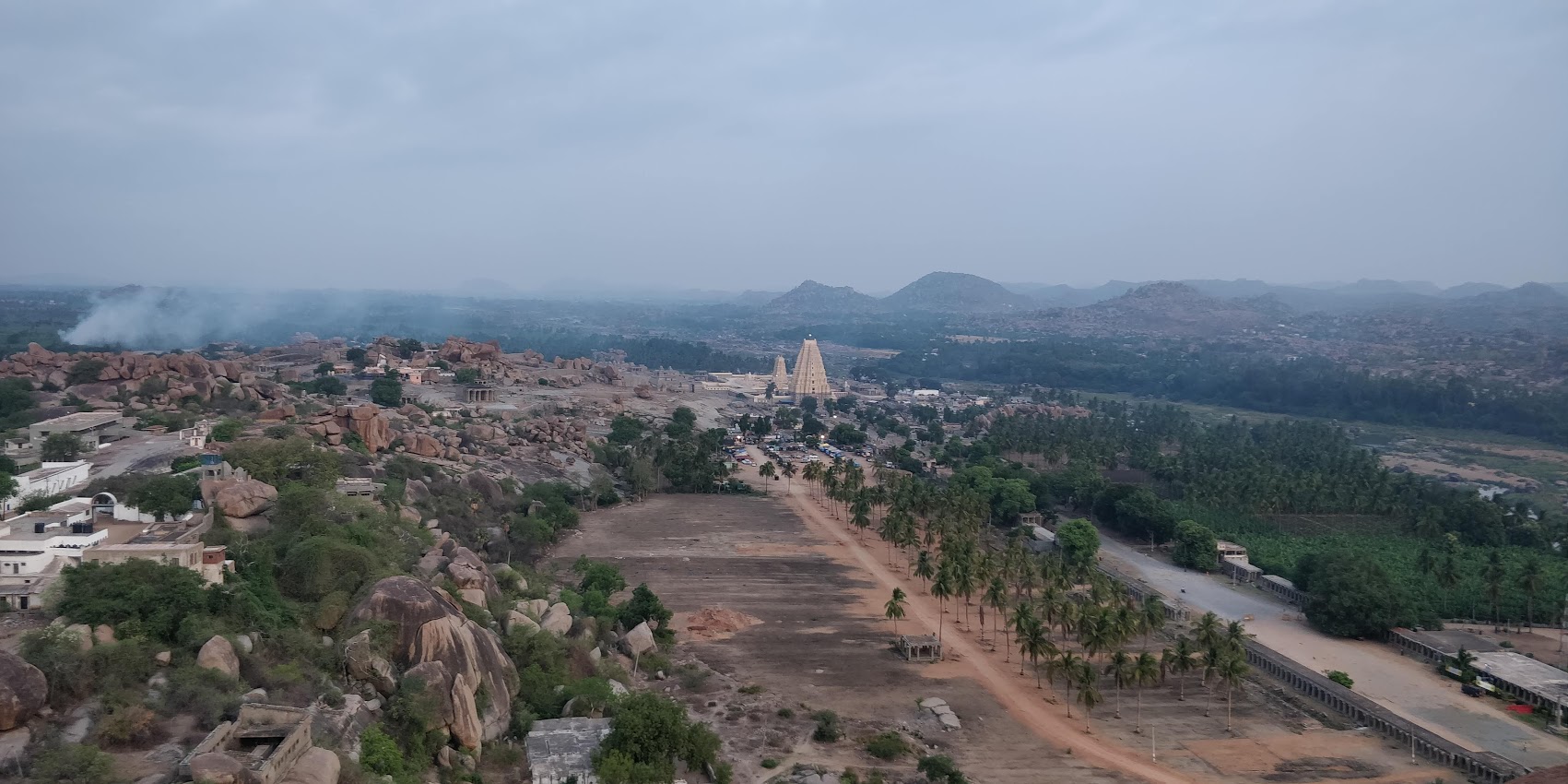 View from Mathanga hill | Credits: Priyanka Raga
View from Mathanga hill | Credits: Priyanka Raga
What’s this
This is a rough guide to plan your weekend trip to Hampi.
Hampi is a UNESCO world heritage site located on the banks of the river Tungabhadra. It is connected with Hyderabad, Bengaluru and Goa through overnight buses and trains. Hampi has a warm, dry climate year-round. Winter (Dec–Feb) is a common time to visit as the weather is cooler. The hot summer (Mar–Jun) is less busy, and is followed by the monsoon season.
Day 0

Secunderabad Railway station | Credits: Vinay Narayanan
Travel
We started from Hyderabad on a friday night aboard the Manuguru - CSMT Kohlapur Express. As is with Indian Railways 😆, the train got delayed by 4 hours. You might lose the first half of your day at Hampi, so plan accordingly. Sleep well as you have to be well rested for the day after. Alternately, you can drive overnight from Hyderabad/Bengaluru.
IMPORTANT: reserve tickets at least a month before to avoid hassle
Day 1
You’ll arrive at the nearest railway station - Hospete Junction. Hampi is around 12 kilometers from Hospete, You can either choose to take an autorickshaw or board the bus to Hampi from there.
 Hospete Junction | Credits: Priyanka Raga
Hospete Junction | Credits: Priyanka Raga
Stay
You’ll arrive in Hampi close to the ancient bazaar and Virupaksha temple, there are lot of homestays here. You can pick any one for cheap with a decent bathroom. We chose one with a view. Luxury options like Hyatt are available at least 30 kilometers away.
IMPORTANT: prebook the stay
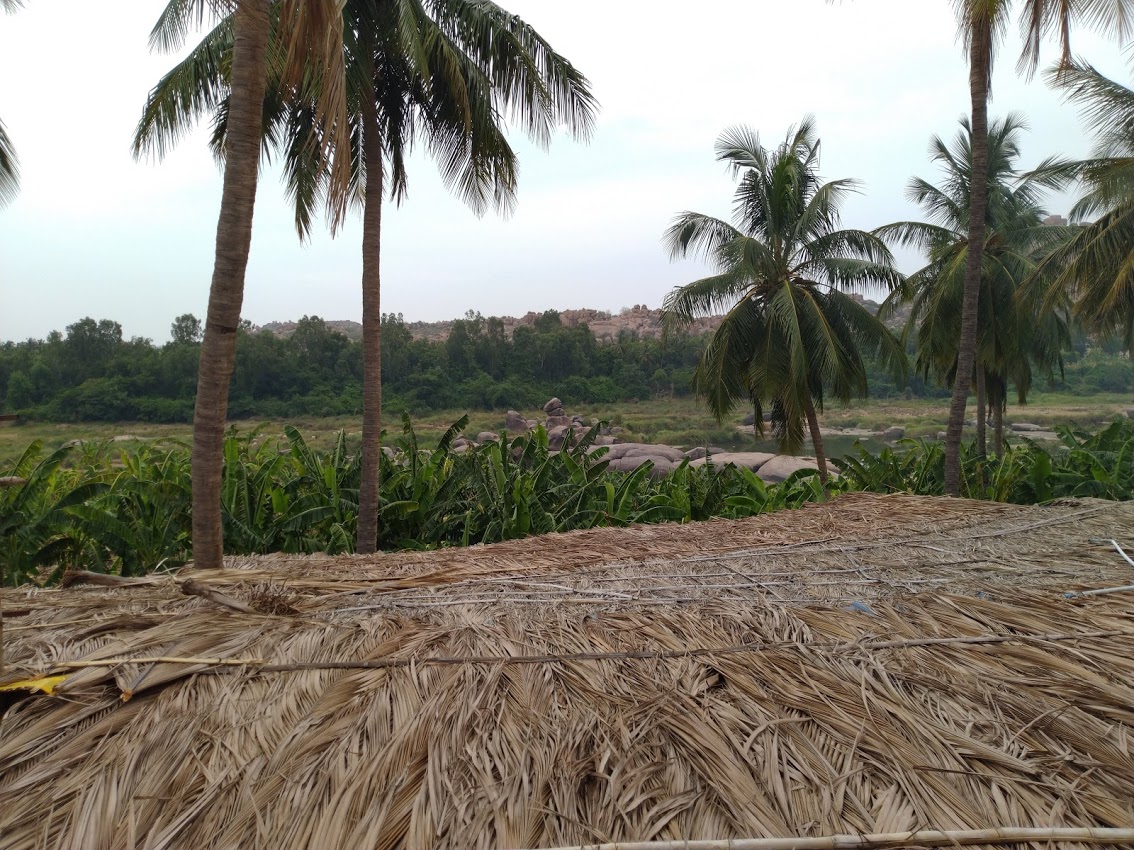 View from homestay
View from homestay
Food
Good option for breakfast is “Old Chillout”. Their English breakfast and pancakes are top notch. You can play with the kittens and dogs that frequent the place.

English breakfast at chillout | Credits: Priyanka Raga
 The hambs at chillout
The hambs at chillout
Lunch and dinner is really nice at “Mango Tree”. They have various cuisines and comfortable floor-deewan style seating.
 Mango Tree | Credits: Vinay Narayanan
Mango Tree | Credits: Vinay Narayanan
There are lot of other options around if you want to explore.
IMPORTANT: Non-vegetarian food is prohibited in the ruins area, so stick to veg or eggs. Too much craving?? Travel outside the ruins area to find places that serve meat
Start your adventure
Durga Temple
Start in an auto to the Durga temple near Anegundi. There’s a scenic view to experience from the top and few small attractions nearby including a Goshala and a cave.
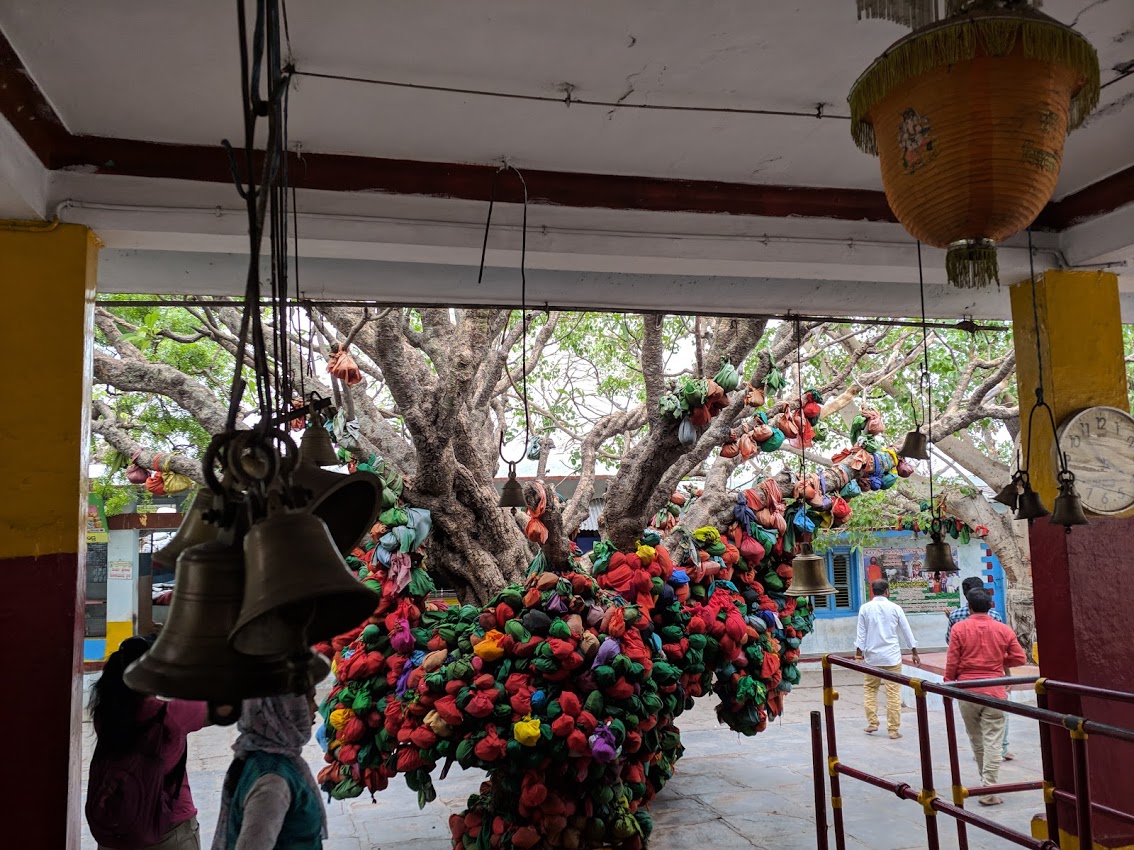 Durga Temple | Credits: Vinay Narayanan
Durga Temple | Credits: Vinay Narayanan
Lakshmi Temple
Now take an auto to reach the ancient Lakshmi temple in Hanumanahalli. You’ll be greeted by many monkeys and the serene rectangular tank - Pampa Sarovar.
 Pampa Sarovar | Credits: Vinay Narayanan
Pampa Sarovar | Credits: Vinay Narayanan

Monkeys at Lakshmi temple | Credits: Vinay Narayanan
Anjanadri
Now take an auto to reach Anjanadri, the hill on which Hanuman was supposedly born. You’ll have to climb 575 steps to reach the top, but the view it offers is worth the hassle. There’s a temple on top which has a floating rock supposedly from the rama-setu.
 View from atop Anjanadri
View from atop Anjanadri
Sunset point
A short hike from the top of Anjanadri-betta on boulders will take you to a spot famous for watching the sun set amidst the tantalizing landscape.
IMPORTANT: Make sure you reach here some time before the sunset, so you don’t miss the opportunity to chill out and take a timelapse

Just a tree
 Sunset point
Sunset point
Virupaksha Temple
Now rush back in an auto to Virupaksha temple near your homestay. It closes around 8:15PM. If you’re lucky you’ll be blessed by the temple elephant - Lakshmi. The elephant pays homage to the deity and the temple closes for the day. Alternately you can go there in the early hours of the next morning to witness the elephant’s daily bath ritual (you perv 🤬).

Virupaksha Temple | Credits: Vinay Narayanan
 Lakshmi the elephant
Lakshmi the elephant
End of day
Have dinner at Mango tree and go to sleep. The first day was mostly hopping between places in an auto. The second day will be completely on moped/cycle. Wake up at least an hour before sunrise the next morning
Day 2
IMPORTANT: Hire a guide for the full day and ask him to wait outside Achutaraya temple an hour after you start for Mathanga hill
Mathanga Hill
Walk from you homestay past the bazaar street opposite to Virupaksha temple to reach the Mathanga hill and start climbing to witness the sunrise. Bring along headlight/torches if it’s very dark. Breathe in the view and take some goofy pictures. You’ll find many millipedes along the way.
 Millipede
Millipede
 Achutaraya temple view from atop Mathanga hill
Achutaraya temple view from atop Mathanga hill
Achutaraya Temple
Climb down the Mathanga hill on the other side to enter an intricate temple complex that is the Achutaraya Temple. The Achutaraya temple is an ancient Vaishnavite shrine.
 Achutaraya Temple
Achutaraya Temple
Like every other major Vijayanagara temple complex, Achutaraya temple has it’s own ancient bazaar street right outside, Meet your guide here.
 The bazaar opposite Achutaraya temple
The bazaar opposite Achutaraya temple
Start walking towards the Vitthala temple complex. You’ll start seeing a lot of interesting structures along the way, make sure to ask your guide about them.
Few of these things are:
King’s balance. This was the place where the annual tulabhara or the weighting of the king against riches and grain used to take place. The riches and grain are then distributed among the poor.

King’s Balance
Temple Barracks. These were used by the soldiers protecting the temple.

Temple Barracks
And there are a lot of Mantapas (Open walled structures)
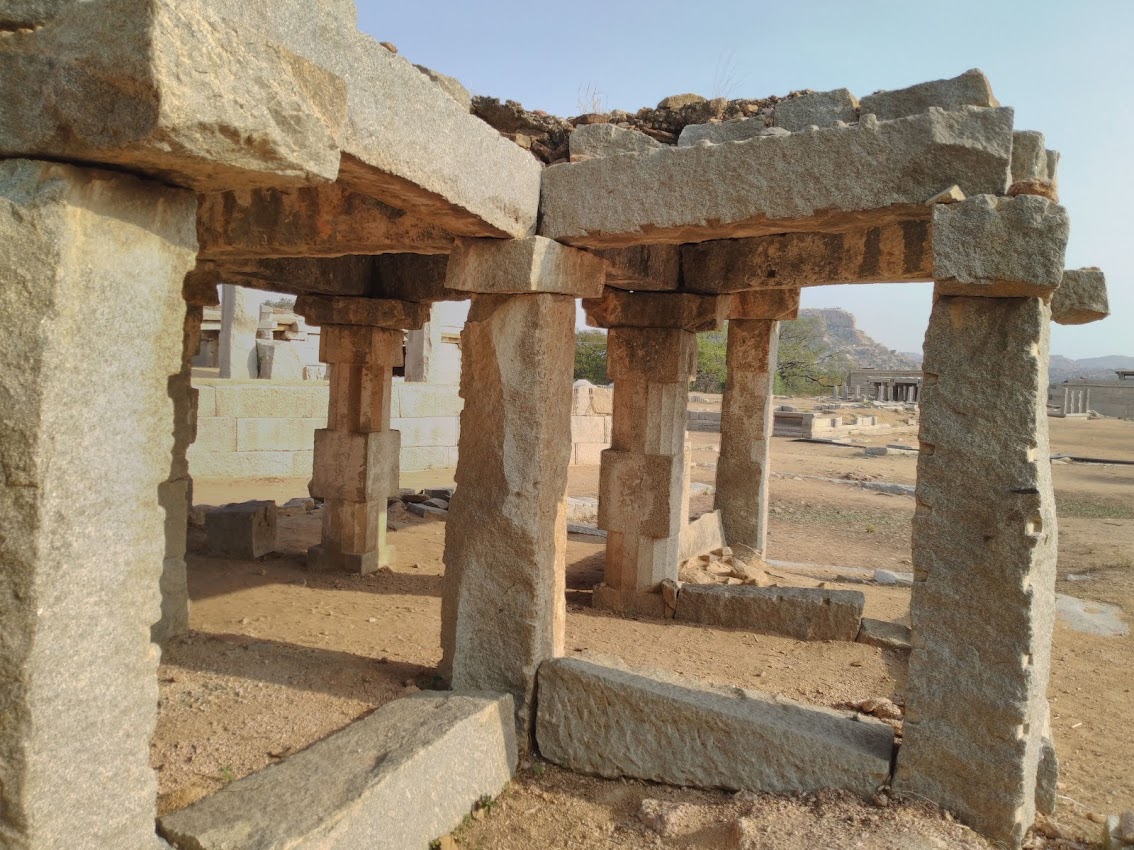
Mantapa

Krishnadevaraya and his two wives
There’s a temple with Varaha seal on both sides of the entry gate on the way to Vitthala temple.
You’ll reach the Vitthala temple complex after a short walk.
Vitthala Temple
Vitthala Temple is a 15th century temple dedicated to Vitthala-Vishnu. It has many attractions including the famous stone-chariot featured on the Rs. 50 note, musical pillars inside the Ranga Mandapa, Marriage hall and Ramayana carvings.
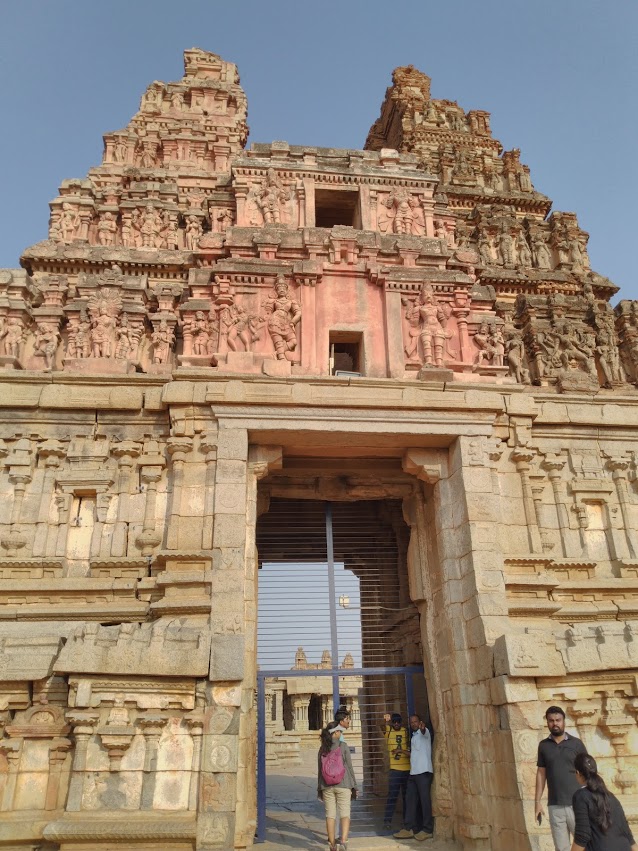
Vitthala Temple

Stone chariot

Musical Pillars

One of the many mantapas inside Vitthala temple

Carvings depicting the stories in Ramayana
After coming out of Vitthala temple, start walking back along the bank of river Tungabhadra.
You’ll see a small structure along the bank. This is the Purandaradasa Mantapa in which the great poet Purandaradasa who composed more than 75,000 classical compositions sat and composed his songs.

Purandaradasa Mantapa at a distance
Keep walking and you’ll come to Kodandarama Temple. Here you can find coracle boat rides, if you’re up for it. Keep walking onto Hampi Baazar Street and then your homestay.

Kodandarama Temple

Coracle point
IMPORTANT: Have breakfast now and check out of the homestay if you’re only staying for 2 days as you’ll not be needing the room anymore and can avoid another day’s charge
Go hire bicycles/mopeds now. They’ll be located very close to the homestays.
IMPORTANT: Don’t forget to take locks from the vendor and lock your cycle whenever you’re leaving it outside
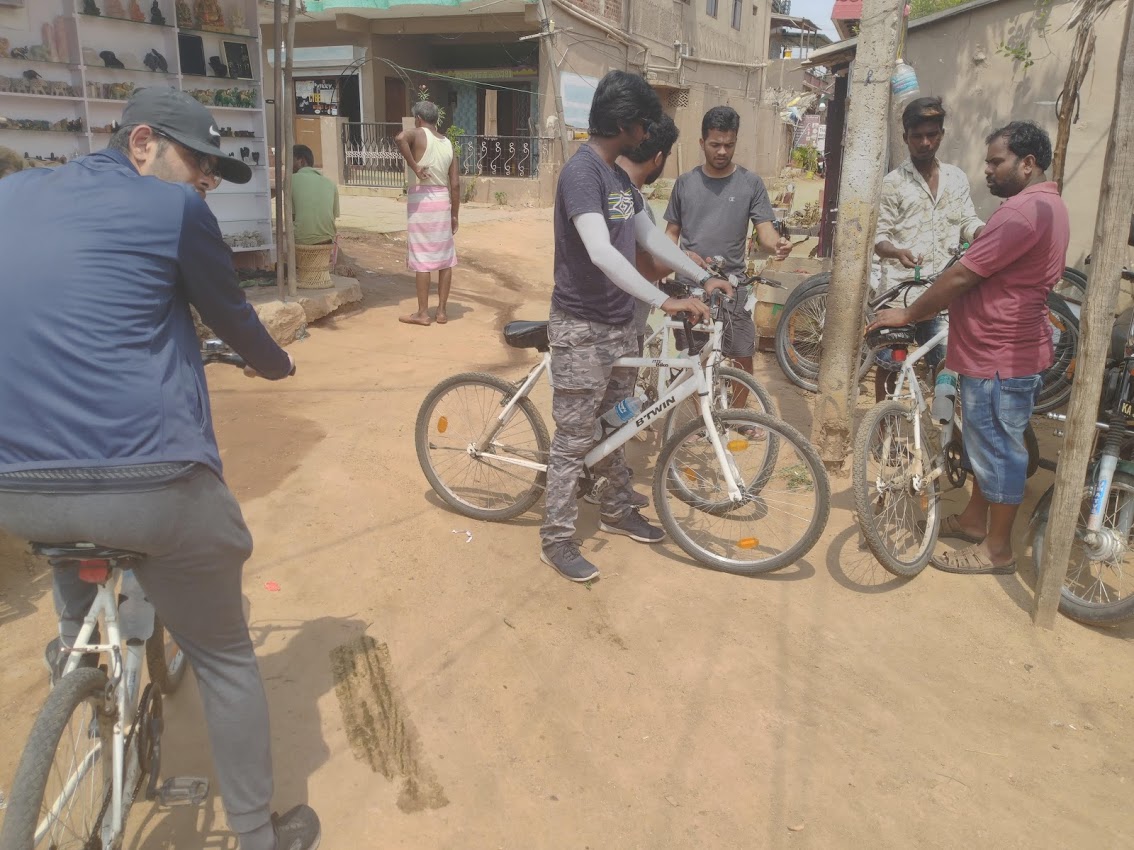
Bicycles
Your guide will be going on their motorcycle from monument to monument, just follow them.
Hemakuta group of temples and Kadalekalu Ganesha
There’s a monolithic statue of ganesha that was commisioned in the Vijayanagara era by a peanut merchant.
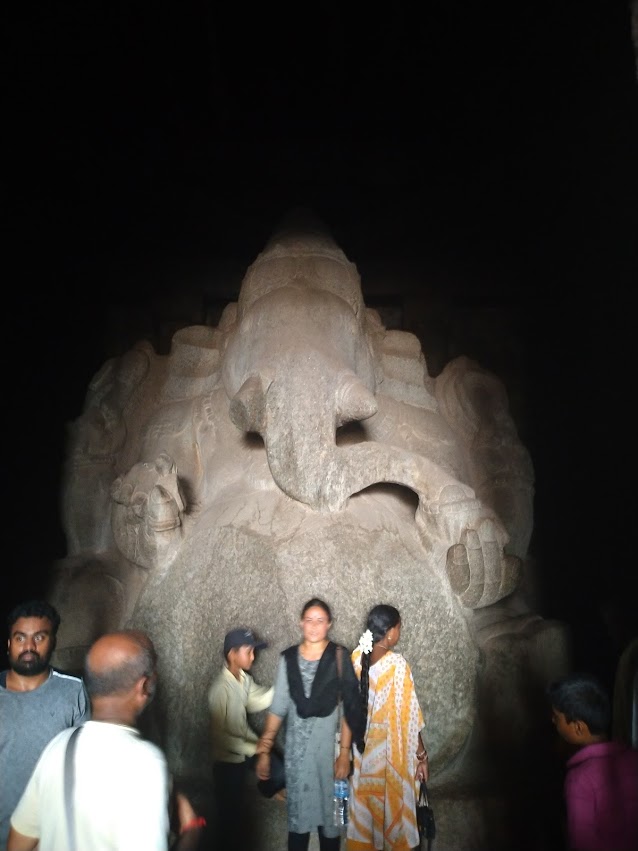
Kadalekalu Ganesha
Badavilinga temple
A shivalinga surrounded by water from a canal commisioned in the Vijayanagara era by a poor woman.

Badavilinga Temple

Path across the monuments | Credits: Priyanka Raga
Underground Shiva Temple
A shiva temple built below ground level, the main sanctum remains flooded with water in monsoon. Bats have made it their home and an extensive stench of Guano prevails.

Underground Shiva Temple | Credits: Priyanka Raga
From here you’ll go on to see a lot of royalty related monuments. For most part, only their basements survive. The wooden structures have been destroyed and burnt by invaders. Few of them did not pass the test of time like the Nobleman’s quarters.
Hazararama Temple
A rama temple located in the Royal enclosure with beautiful bas relics and black granite columns inside.
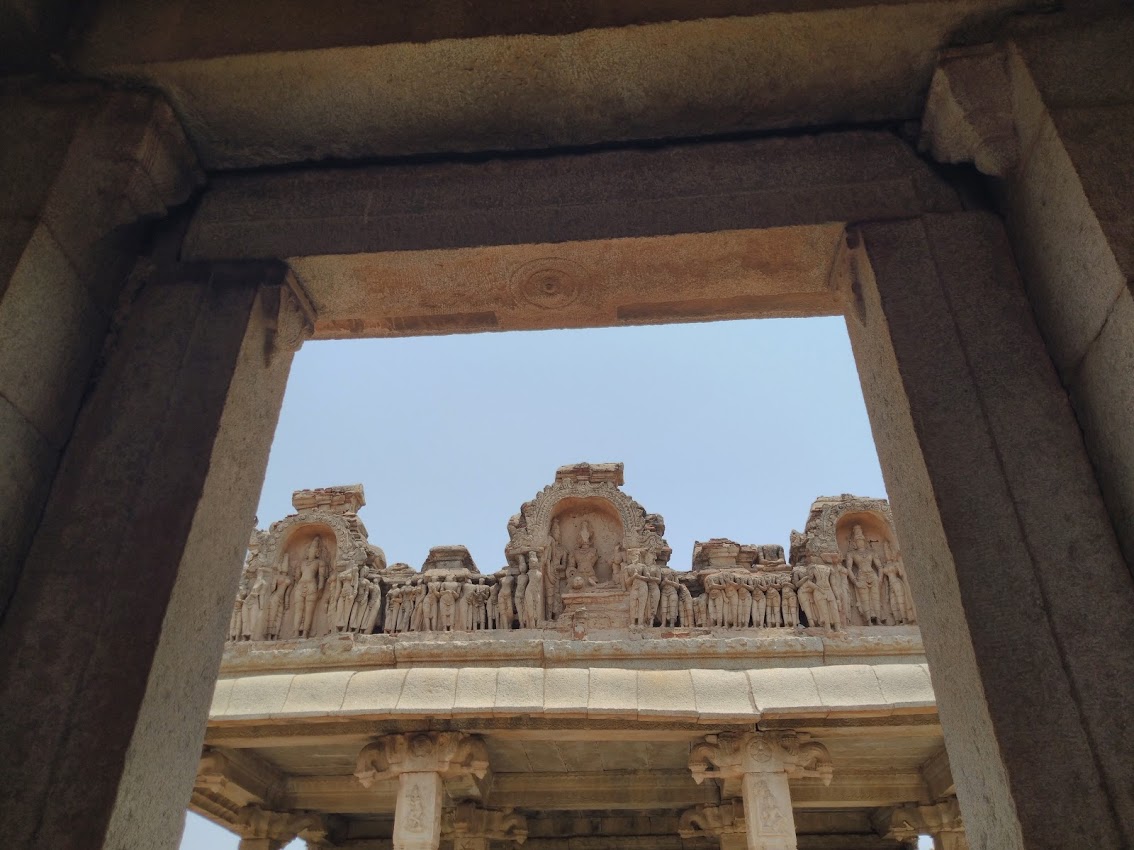
Hazararama Temple

Hazararama Temple outer wall consisting of panels depicting scenes from the Ramayana
Hidden Treasury
An underground chamber to store riches

Hidden Treasury
Aquaduct
An engineering marvel of the bygone era, it brought water from a canal to the bath.

Aquaduct
Square stepped tank
A beautiful symmetric bath tank made from black schist stones used by the royals.

Stepped Tank
Mahanavami Dibba
A large pedestal on which the royals performed Mahanavami celebrations and rituals.

Mahanavami Dibba
Lotus Mahal
Another engineering marvel with terracotta pipes inside pillars connected to a water tank on the top. The water evaporates through the lime pillars resulting in a cool breeze. Meant for the queen.

Lotus Mahal
Elephant’s Stables
The stable that used to house the 11 royal elephants. The neighbouring structure for housing 11 mahouts has been converted to a museum.

Elephant’s Stables
Cycle from here to Queen’s bath.
Queen’s bath
The royal bath for the king and his queens. It is surrounded by a moat

Queen’s bath
Now have lunch at the Pink Mango nearby

The Thali at Pink Mango
Archaeological Museum, Kamalapura
The museum is just opposite Pink Mango. It has a lot of coins,carvings and artifacts on display.

Pillars on display at the museum
If you’ve booked a bus/train later than 8:00 PM and you’ve finished everything so far by 5:00 PM, you can visit the Daroji bear sanctuary nearby which closes at 5:30 PM.
Cycle back to Hampi Bazaar street infront of Virupaksha temple, you’ll find a bus/auto to take you to Hospete to board your train/bus.
Additional
You can extend your stay for few more days and fit in a visit to Badami, Aihole and Pattadakal.
If you’re starting from Hyderabad and don’t want the hassle of planning everything, book a trip with Hyderabad Trekking Club like I did.
Fin.